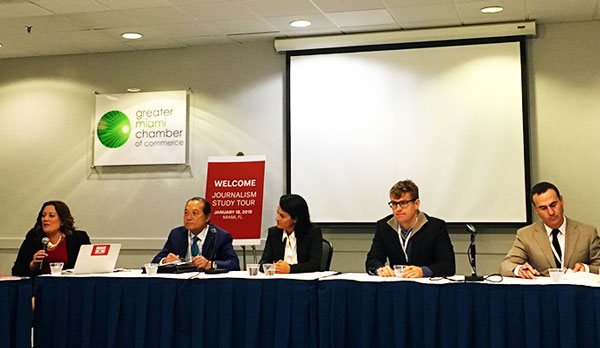With all its glimmering waterfront high-rises, South Florida still has a thick cloud hovering over the issue of affordable housing. There is enormous demand from residents, but the supply is not there.
A push for more incentives and subsidies and an effort to retool existing apartment stocks are a few of the potential solutions to increasing the amount of affordable housing. Those were just some of the ideas during Thursday’s forum on the topic, hosted by Make Room Inc.
The event brought together developers, city officials, researchers and reps from nonprofit organizations to talk about the issues circling affordable housing in South Florida.
“It’s really hard to do affordable housing without any help,” said Matthew Rieger, president and CEO of affordable housing developer, Housing Trust Group. “The demand is there. I have a triple-digit waiting list at every affordable housing property that I own,” Rieger said. “Really what I see in my mind is a supply problem.”
Data released by the FIU Metropolitan Center shows 34 percent of renters in Miami-Dade County and 30 percent in Broward County spend more than half of their income on rent and utilities.
In each county, the data reveals more than half of renters are considered “cost-burdened,” meaning 30 percent of their income is being spent on rent and utilities.
When looking at existing rents and asking rents “the gaps are huge,” Ned Murray, co-director of the FIU Metropolitan Center, said. “Once people reach that 30 percent mark they begin to leave.”
On a national level, 11 million households representing about 25 million people are paying half of their income in rent, said Ali Solis, president and CEO of the housing nonprofit. That number is likely to grow to 15 million by 2020.
Real estate experts at the forum agreed, there can be ripple effects on a surrounding community if decent living conditions are not met for low-wage, service-industry workers.
Developer Avra Jain of Vagabond Group, started offering subsidized housing for her staff, after hearing one of her hospitality workers – a single mother – had to take three buses to get to work everyday. The routine often made her late to work.
“I challenge everyone to think that maybe goodwill matters enough,” Jain said. She’s known for her restoration and preservation work on such projects like Miami River Inn and the Vagabond Motel. At the event, Jain said she likes the idea of taking existing stock and renovating it so it can last another 10 to 20 years.
Foreign investment is also a key component to development in the area. The influx has increased housing prices, Murray said.
The fear of having the value of tax credits drop is also an issue. If that happens, it would derail investors from using the Low Income Housing Tax Credit program, established by Congress in 1986. Rieger said he believes it resulted in 20 percent less equity toward affordable housing, last year.
The LIHTC program allows for corporations and banks to offset tax liability by investing directly in affordable housing projects. In short, Rieger calls it a credit on an ultimate tax bill, and one of the largest tools affordable housing developers use.
“We’re capped on income and not capped on expenses,” Rieger said. “But at the end of the day, I’m happy because I get to help people.”
Francis Suarez, the recently elected mayor of Miami, said the city is trying to do its part to spur affordable housing development.
The mayor said he’s working on creative solutions to fight the affordable housing issue. He pointed to some incentives like a measure that grants density bonuses to residential projects that include units designated as workforce and affordable housing.
The mayor also mentioned a recently approved ordinance that reduces the minimum size of micro-units from 400 square feet to 275 square feet.
“[Miami] is a victim of its own success,” Suarez said. “We’re attracting capital from everywhere in the world: Israel, Russia, China, everyone wants to invest in Miami. We’re going to get a flood of people and that’s a problem.”




